Shengqian Han
A Model-based DNN for Learning HMIMO Beamforming
Apr 28, 2025Abstract:Holographic MIMO (HMIMO) is a promising technique for large-scale MIMO systems to enhance spectral efficiency while maintaining low hardware cost and power consumption. Existing alternating optimization algorithms can effectively optimize the hybrid beamforming of HMIMO to improve the system performance, while their high computational complexity hinders real-time application. In this paper, we propose a model-based deep neural network (MB-DNN), which leverages permutation equivalent properties and the optimal beamforming structure to jointly optimize the holographic and digital beamforming. Simulation results demonstrate that the proposed MB-DNN outperforms benchmark schemes and requires much less inference time than existing alternating optimization algorithms.
Precoder Learning by Leveraging Unitary Equivariance Property
Mar 12, 2025Abstract:Incorporating mathematical properties of a wireless policy to be learned into the design of deep neural networks (DNNs) is effective for enhancing learning efficiency. Multi-user precoding policy in multi-antenna system, which is the mapping from channel matrix to precoding matrix, possesses a permutation equivariance property, which has been harnessed to design the parameter sharing structure of the weight matrix of DNNs. In this paper, we study a stronger property than permutation equivariance, namely unitary equivariance, for precoder learning. We first show that a DNN with unitary equivariance designed by further introducing parameter sharing into a permutation equivariant DNN is unable to learn the optimal precoder. We proceed to develop a novel non-linear weighting process satisfying unitary equivariance and then construct a joint unitary and permutation equivariant DNN. Simulation results demonstrate that the proposed DNN not only outperforms existing learning methods in learning performance and generalizability but also reduces training complexity.
Quantization Design for Deep Learning-Based CSI Feedback
Mar 11, 2025Abstract:Deep learning-based autoencoders have been employed to compress and reconstruct channel state information (CSI) in frequency-division duplex systems. Practical implementations require judicious quantization of encoder outputs for digital transmission. In this paper, we propose a novel quantization module with bit allocation among encoder outputs and develop a method for joint training the module and the autoencoder. To enhance learning performance, we design a loss function that adaptively weights the quantization loss and the logarithm of reconstruction loss. Simulation results show the performance gain of the proposed method over existing baselines.
Distributed Resource Block Allocation for Wideband Cell-free System
Mar 10, 2025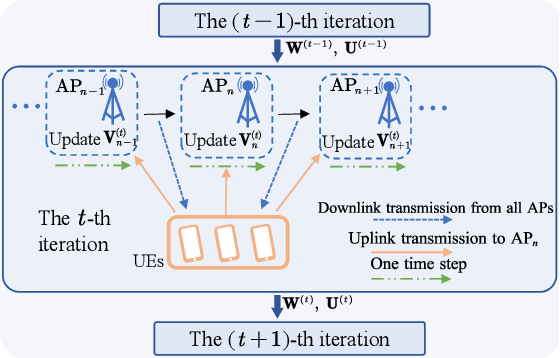
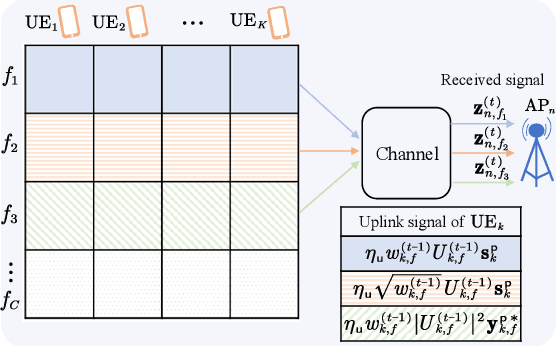
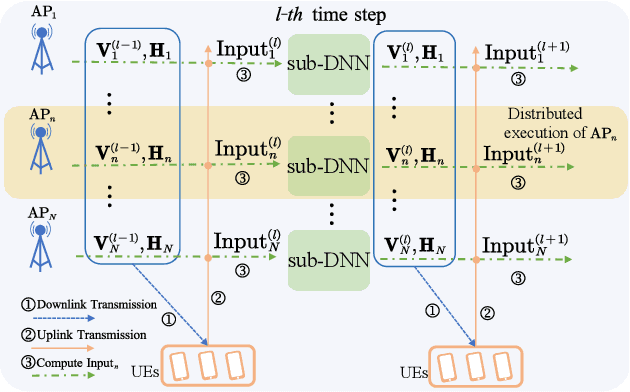
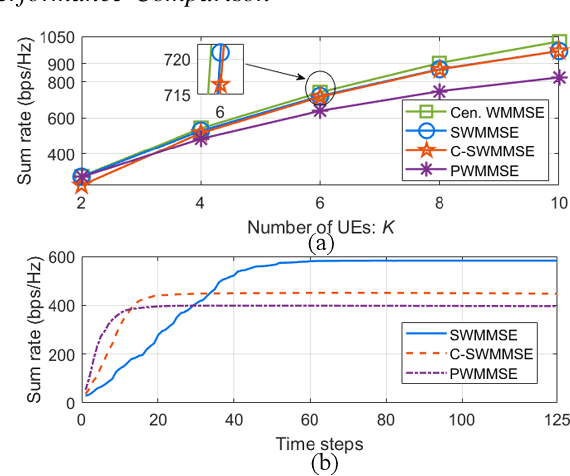
Abstract:This paper studies distributed resource block (RB) allocation in wideband orthogonal frequency-division multiplexing (OFDM) cell-free systems. We propose a novel distributed sequential algorithm and its two variants, which optimize RB allocation based on the information obtained through over-the-air (OTA) transmissions between access points (APs) and user equipments, enabling local decision updates at each AP. To reduce the overhead of OTA transmission, we further develop a distributed deep learning (DL)-based method to learn the RB allocation policy. Simulation results demonstrate that the proposed distributed algorithms perform close to the centralized algorithm, while the DL-based method outperforms existing baseline methods.
Learning of Uplink Resource Allocation with Multiuser QoS Constraints
Mar 09, 2025Abstract:In the paper the joint optimization of uplink multiuser power and resource block (RB) allocation are studied, where each user has quality of service (QoS) constraints on both long- and short-blocklength transmissions. The objective is to minimize the consumption of RBs for meeting the QoS requirements, leading to a mixed-integer nonlinear programming (MINLP) problem. We resort to deep learning to solve the problem with low inference complexity. To provide a performance benchmark for learning based methods, we propose a hierarchical algorithm to find the global optimal solution in the single-user scenario, which is then extended to the multiuser scenario. The design of the learning method, however, is challenging due to the discrete policy to be learned, which results in either vanishing or exploding gradient during neural network training. We introduce two types of smoothing functions to approximate the involved discretizing processes and propose a smoothing parameter adaption method. Another critical challenge lies in guaranteeing the QoS constraints. To address it, we design a nonlinear function to intensify the penalties for minor constraint violations. Simulation results demonstrate the advantages of the proposed method in reducing the number of occupied RBs and satisfying QoS constraints reliably.
Gradient-Driven Graph Neural Networks for Learning Digital and Hybrid Precoder
Mar 08, 2025Abstract:The optimization of multi-user multi-input multi-output (MU-MIMO) precoders is a widely recognized challenging problem. Existing work has demonstrated the potential of graph neural networks (GNNs) in learning precoding policies. However, existing GNNs often exhibit poor generalizability for the numbers of users or antennas. In this paper, we develop a gradient-driven GNN design method for the learning of fully digital and hybrid precoding policies. The proposed GNNs leverage two kinds of knowledge, namely the gradient of signal-to-interference-plus-noise ratio (SINR) to the precoders and the permutation equivariant property of the precoding policy. To demonstrate the flexibility of the proposed method for accommodating different optimization objectives and different precoding policies, we first apply the proposed method to learn the fully digital precoding policies. We study two precoder optimization problems for spectral efficiency (SE) maximization and log-SE maximization to achieve proportional fairness. We then apply the proposed method to learn the hybrid precoding policy, where the gradients to analog and digital precoders are exploited for the design of the GNN. Simulation results show the effectiveness of the proposed methods for learning different precoding policies and better generalization performance to the numbers of both users and antennas compared to baseline GNNs.
Precoder Learning for Weighted Sum Rate Maximization
Mar 06, 2025Abstract:Weighted sum rate maximization (WSRM) for precoder optimization effectively balances performance and fairness among users. Recent studies have demonstrated the potential of deep learning in precoder optimization for sum rate maximization. However, the WSRM problem necessitates a redesign of neural network architectures to incorporate user weights into the input. In this paper, we propose a novel deep neural network (DNN) to learn the precoder for WSRM. Compared to existing DNNs, the proposed DNN leverage the joint unitary and permutation equivariant property inherent in the optimal precoding policy, effectively enhancing learning performance while reducing training complexity. Simulation results demonstrate that the proposed method significantly outperforms baseline learning methods in terms of both learning and generalization performance while maintaining low training and inference complexity.
Learning Wideband User Scheduling and Hybrid Precoding with Graph Neural Networks
Mar 06, 2025
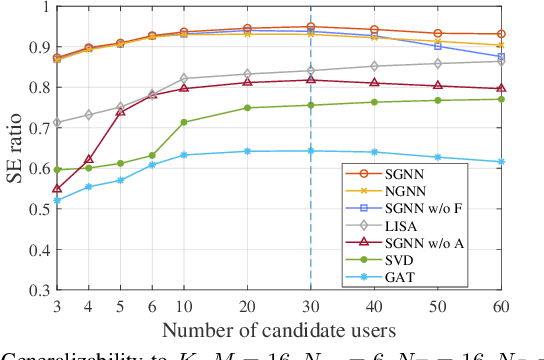
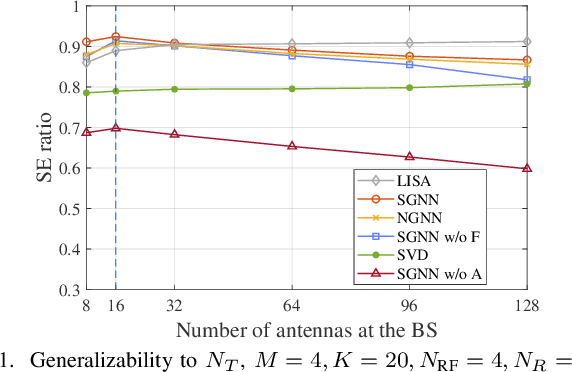

Abstract:Spatial-frequency scheduling and hybrid precoding in wideband multi-user multi-antenna systems have never been learned jointly due to the challenges arising from the massive user combinations on resource blocks (RBs) and the shared analog precoder among RBs. In this paper, we strive to jointly learn the scheduling and precoding policies with graph neural networks (GNNs), which have emerged as a powerful tool for optimizing resource allocation thanks to their potential in generalizing across problem scales. By reformulating the joint optimization problem into an equivalent functional optimization problem for the scheduling and precoding policies, we propose a GNN-based architecture consisting of two cascaded modules to learn the two policies. We discover a same-parameter same-decision (SPSD) property for wireless policies defined on sets, revealing that a GNN cannot well learn the optimal scheduling policy when users have similar channels. This motivates us to develop a sequence of GNNs to enhance the scheduling module. Furthermore, by analyzing the SPSD property, we find when linear aggregators in GNNs impede size generalization. Based on the observation, we devise a novel attention mechanism for information aggregation in the precoder module. Simulation results demonstrate that the proposed architecture achieves satisfactory spectral efficiency with short inference time and low training complexity, and is generalizable to the numbers of users, RBs, and antennas at the base station and users.
Learn to Optimize Resource Allocation under QoS Constraint of AR
Jan 27, 2025Abstract:This paper studies the uplink and downlink power allocation for interactive augmented reality (AR) services, where live video captured by an AR device is uploaded to the network edge and then the augmented video is subsequently downloaded. By modeling the AR transmission process as a tandem queuing system, we derive an upper bound for the probabilistic quality of service (QoS) requirement concerning end-to-end latency and reliability. The resource allocation with the QoS constraints results in a functional optimization problem. To address it, we design a deep neural network to learn the power allocation policy, leveraging the structure of optimal power allocation to enhance learning performance. Simulation results demonstrate that the proposed method effectively reduces transmit powers while meeting the QoS requirement.
ICI-Free Channel Estimation and Wireless Gesture Recognition Based on Cellular Signals
Jan 04, 2024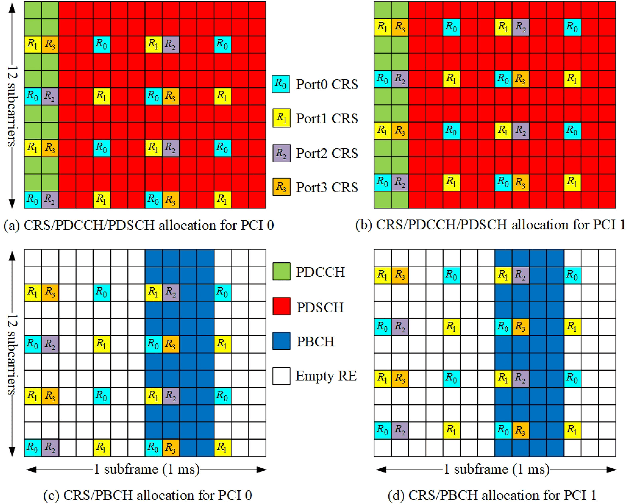
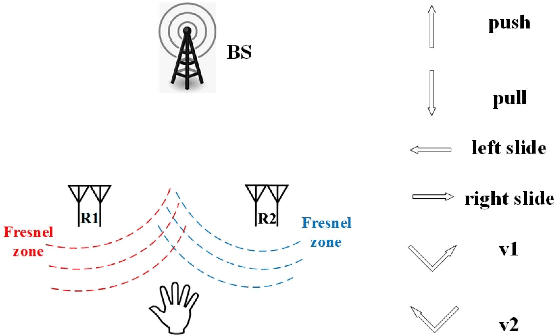
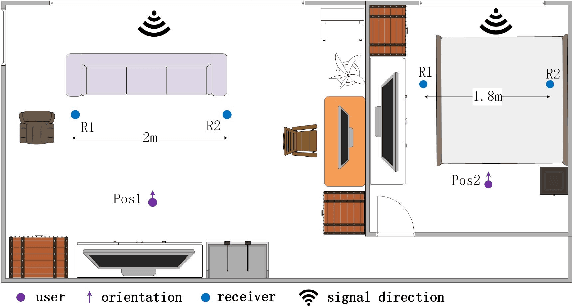

Abstract:Device-free wireless sensing attracts enormous attentions since it senses the environment without additional devices. While cellular signals are good opportunistic radio sources, the influence of inter-cell interference (ICI) on wireless sensing has not been adequately addressed. In this letter, we first investigate the cause of ICI and its impact on wireless sensing. Then we propose an ICI-free channel estimation method by reconstructing the broadcast signals of adjacent cells and solving simultaneous equations. Wireless gesture recognition can be greatly benefited by ICI mitigation. Finally, we build a prototype system to receive the commercial 4G-LTE signals, and demonstrate the accuracies of wireless gesture recognition under various conditions.
 Add to Chrome
Add to Chrome Add to Firefox
Add to Firefox Add to Edge
Add to Edge